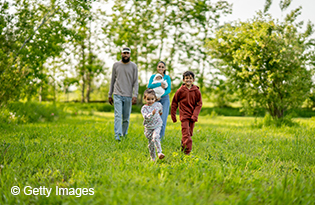Poisonous wild plants still pack an unpleasant punch
7/21/2025 by Nancy Kirscht, APRN, C.N..P.

Whether taking a hike, hunting, cleaning up the garden or camping this summer, wild poisonous plants still can pack an itchy, unpleasant and sometimes painful punch. The devilish duo to be aware of and avoid are wild parsnip and poison ivy (and its cousins, poison oak and poison sumac).
 Wild parsnip. This tall, sturdy plant with its flat, umbrella-like blossom sprinkled with tiny yellow flowers has run rampant this season. All it takes is skin contact with its poisonous sap, a little sunlight and yeow! The chemical reaction, called phytophotodermatitis, is so corrosive that it can cause a rash and blistering as bad as second-degree burns. The blisters can take weeks to clear up and may leave scars and skin discoloration.
Wild parsnip. This tall, sturdy plant with its flat, umbrella-like blossom sprinkled with tiny yellow flowers has run rampant this season. All it takes is skin contact with its poisonous sap, a little sunlight and yeow! The chemical reaction, called phytophotodermatitis, is so corrosive that it can cause a rash and blistering as bad as second-degree burns. The blisters can take weeks to clear up and may leave scars and skin discoloration.
This non-native plant, is found along roadsides and fence rows, the edges of prairie areas, woodlands and trails, and in abandoned fields and unmowed pastures.  Your best protection is to wear long sleeves, pants and gloves. If you do come in contact with wild parsnip:
Your best protection is to wear long sleeves, pants and gloves. If you do come in contact with wild parsnip:
- Cover the affected area with a cool, wet cloth
- If blisters appear, try not to rupture them for as long as possible
- To avoid infection, keep the area clean and apply antiseptic cream
- Contact your care team or clinician if the blisters get worse or there are signs of infection
 Poison ivy (poison oak, poison sumac). "Leaves of three, let it be." That's the old trick for identifying and steering clear of poison ivy. Good advice! Poison ivy and its cousins can produce an itchy, long-lasting rash caused by an allergic reaction to the oily resin, called urushiol, which is found in the leaves, stems and roots.
Poison ivy (poison oak, poison sumac). "Leaves of three, let it be." That's the old trick for identifying and steering clear of poison ivy. Good advice! Poison ivy and its cousins can produce an itchy, long-lasting rash caused by an allergic reaction to the oily resin, called urushiol, which is found in the leaves, stems and roots.
You can get the oil on your skin not only from the plant, but also from clothing, tools, equipment or animal fur or hair. If you're burning with poison ivy, inhaling the oil is also dangerous, which may cause difficulty breathing.
If you've come in contact with the oil, wash your skin with soap and water, and even your clothing, as soon as possible to reduce your chance of getting the rash. Poison Ivy doesn’t spread after contact with the plant, but it can seem that way. Symptoms typically occur 4-96 hours after exposure and peak by day 14 but new areas of rash can occur for up to 21 days after exposure. Treat mild cases of poison ivy rash at home with soothing lotions and cool baths. If the rash is severe or widespread, or on your face or genitals, you may need a prescription medication.
See your care team or clinician if:
- Your skin continues to swell.
- The rash affects your eyes, mouth or genitals.
- Blisters are oozing pus.
- You develop a fever greater than 100 F. (37.8 C.).
- The rash doesn't get better within a few weeks.
- You're having respiratory symptoms.
Allergic reactions to any poisonous plant can be worse after each new exposure, because your body becomes primed to react to the toxins.
 Stinging nettles. While nettles have been used for centuries in herbal teas and remedies, inadvertently coming in contact with tiny spines on the stalk is plenty painful. These tall, spiky plants grow along streams, woodlands, trails and roadsides. If you come in contact with nettles, wash the area with soap and plenty of water to remove the sting.
Stinging nettles. While nettles have been used for centuries in herbal teas and remedies, inadvertently coming in contact with tiny spines on the stalk is plenty painful. These tall, spiky plants grow along streams, woodlands, trails and roadsides. If you come in contact with nettles, wash the area with soap and plenty of water to remove the sting.
Nancy Kirscht, APRN, C.N.P., is a nurse practitioner in the Department of Family Medicine. She practices at Mayo Clinic Express Care in Rochester, Minnesota. Her interests include acute care, women's health and preventing antimicrobial overuse. She enjoys traveling, exploring new places and spending time with her family.
